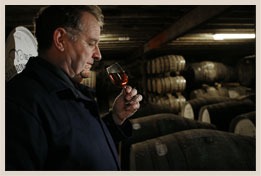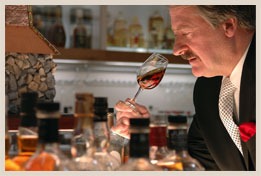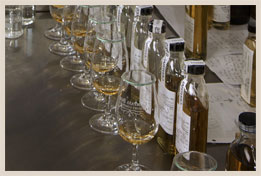Tasting, an art to be cultivated
There are two main families of whisky. The first, which represents around 95% of national consumption, groups together what can be called everyday whiskies. These are the whiskies most commonly consumed when enjoying a cocktail or out at a night club, and they’re generally taken with ice or soda water. Most are Scotch blends or Kentucky bourbons. With these whiskies the brand matters less than the price, which is where the common practice of stocking “pouring whiskies” comes from. The second category, tasting whiskies, pertains particularly to single malts, Irish pure pot stills, single barrels and small batch bourbons, and to be fully appreciated, they require a sort of ritual that professionals and the general public sometimes have a tendency to forget. For the tasting to be successful, the location, choice of glass, time at which the tasting takes place and the addition of water are all important factors.
Is there a perfect environment for tasting?

An environment which is too hot, or smoky or simply polluted with overpowering fragrances (cigarettes or perfume) will obviously not be conducive to a successful tasting. Similarly, it is better to choose an environment with sufficient lighting for the analysis of the whisky’s visual characteristics. Those taking part also need to feel that they are ‘in condition’, which can mean different things for different people. Some people prefer to be isolated to taste better. Others, on the other hand, prefer being able to discuss the whisky with others. In any event, tasting requires a minimum level of concentration.
Is there an ideal glass for tasting?

The tumbler is the whisky glass most commonly found in bars and homes. It’s a straight glass with a thick bottom and wide opening. Although this type of glass is perfect for everyday whiskies enjoyed with ice or soda, it is not so ideal for other categories of whisky. The main aim of a tasting glass is to help showcase the aromatic palette of the whisky. INAO-style wine glasses, port glasses or copitas (sherry glasses) are perfect for this. In distilleries in Scotland, Ireland and Kentucky, it is the copita glass that is most commonly found. It is also the type of glass that blenders use to put their blends together during long nosing sessions. These glasses all feature a tulip shape which enables a better perception of the aromas by concentrating them together. Recently certain glass brands combining aesthetic appeal with this specific shape have appeared on the market.
When is the best moment for a tasting?

Contrary to popular belief, whisky tasting is not only for after a meal. Some fresh and light whiskies make a great aperitif, particularly the floral single malts of the Lowlands and some of the very fruity Irish whiskeys. The lightly peated Islay malts, Bunnahabhain and Bruichladdich in particular, can also be enjoyed in this way. For the end of a meal, it is better to choose a full-bodied or classic whisky, such as single malts aged in casks that have previously contained sherry (Macallan, Glenfarclas) or a very peaty Islay malt such as Laphroaig. A small batch or single barrel bourbon without ice also makes a perfect after-dinner drink. There are also other great occasions for tasting. A fine winter afternoon, after an invigorating walk in the fresh air, offers a perfect opportunity for discovering a whisky.
Does adding water help you taste the whisky better?

There is nothing more infuriating than well-meaning establishments serving your favourite single malt with a little bucket of ice. Fortunately this practice is on its way out. Would anyone ever suggest adding ice to a Bordeaux grand cru? Ice is the enemy of high-quality whisky. It has a hugely anaesthetic effect on the taste buds. On the other hand, it’s not against the rules to add water. When professionals are evaluating a large number of whiskies they will dilute their whisky by 50%. Nonetheless there are still those that are staunchly against the addition of water. Water can help bring out the aromas but it also tends to create uniformity. It can also make the whisky more fluid and change its texture in the process. In the end, deciding whether or not to add water really comes down to individual taste and experience. Now the preparation is over, it’s time to move onto the sensory analysis.